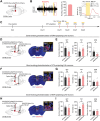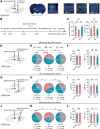Burst firing in Output-Defined Parallel Habenula Circuit Underlies the Antidepressant Effects of Bright Light Treatment
- PMID: 38863324
- PMCID: PMC11321664
- DOI: 10.1002/advs.202401059
Burst firing in Output-Defined Parallel Habenula Circuit Underlies the Antidepressant Effects of Bright Light Treatment
Abstract
Research highlights the significance of increased bursting in lateral habenula (LHb) neurons in depression and as a focal point for bright light treatment (BLT). However, the precise spike patterns of LHb neurons projecting to different brain regions during depression, their roles in depression development, and BLT's therapeutic action remain elusive. Here, LHb neurons are found projecting to the dorsal raphe nucleus (DRN), ventral tegmental area (VTA), and median raphe nucleus (MnR) exhibit increased bursting following aversive stimuli exposure, correlating with distinct depressive symptoms. Enhanced bursting in DRN-projecting LHb neurons is pivotal for anhedonia and anxiety, while concurrent bursting in LHb neurons projecting to the DRN, VTA, and MnR is essential for despair. Remarkably, reducing bursting in distinct LHb neuron subpopulations underlies the therapeutic effects of BLT on specific depressive behaviors. These findings provide valuable insights into the mechanisms of depression and the antidepressant action of BLT.
Keywords: bright light treatment; burst firing; depression; lateral habenula; neural circuits.
© 2024 The Author(s). Advanced Science published by Wiley‐VCH GmbH.
Conflict of interest statement
The authors declare no conflict of interest.
Figures






Similar articles
-
Optogenetic activation of the lateral habenulaD1R-ventral tegmental area circuit induces depression-like behavior in mice.Eur Arch Psychiatry Clin Neurosci. 2024 Jun;274(4):867-878. doi: 10.1007/s00406-023-01743-2. Epub 2024 Jan 18. Eur Arch Psychiatry Clin Neurosci. 2024. PMID: 38236282
-
Chronic Social Defeat Stress Induces Pathway-Specific Adaptations at Lateral Habenula Neuronal Outputs.J Neurosci. 2024 Sep 25;44(39):e2082232024. doi: 10.1523/JNEUROSCI.2082-23.2024. J Neurosci. 2024. PMID: 39164106 Free PMC article.
-
Dorsal raphe projection inhibits the excitatory inputs on lateral habenula and alleviates depressive behaviors in rats.Brain Struct Funct. 2018 Jun;223(5):2243-2258. doi: 10.1007/s00429-018-1623-3. Epub 2018 Feb 19. Brain Struct Funct. 2018. PMID: 29460052
-
Lateral habenula neurocircuits mediate the maternal disruptive effect of maternal stress: A hypothesis.Zool Res. 2022 Mar 18;43(2):166-175. doi: 10.24272/j.issn.2095-8137.2021.362. Zool Res. 2022. PMID: 35008132 Free PMC article. Review.
-
The role of lateral habenula-dorsal raphe nucleus circuits in higher brain functions and psychiatric illness.Behav Brain Res. 2015 Jan 15;277:89-98. doi: 10.1016/j.bbr.2014.09.016. Epub 2014 Sep 16. Behav Brain Res. 2015. PMID: 25234226 Review.
Cited by
-
A cell-type-specific circuit of somatostatin neurons in the habenula encodes antidepressant action in male mice.Nat Commun. 2025 Apr 10;16(1):3417. doi: 10.1038/s41467-025-58591-y. Nat Commun. 2025. PMID: 40210897 Free PMC article.
-
Lateral habenula astroglia modulate the potentiating antidepressant-like effects of bright light stimulation in intractable depression.Front Pharmacol. 2025 Apr 23;16:1592909. doi: 10.3389/fphar.2025.1592909. eCollection 2025. Front Pharmacol. 2025. PMID: 40337515 Free PMC article.
References
-
- a) Collins P. Y., Patel V., Joestl S. S., March D., Insel T. R., Daar A. S., Board S. A., Gl E. C. G. C., Nature 2011, 475, 27; - PMC - PubMed
- b) Kessler R. C., Berglund P., Demler O., Jin R., Koretz D., Merikangas K. R., Rush A. J., Walters E. E., Wang P. S., Jama‐J Am Med Assoc 2003, 289, 3095; - PubMed
- c) Lépine J. P., Briley M., Neuropsychiatr Dis Treat 2011, 7, 3; - PMC - PubMed
- d) Pizzagalli D. A., Annu Rev Clin Psychol 2014, 10, 393. - PMC - PubMed
-
- a) Huang L., Xi Y., Peng Y. F., Yang Y., Huang X. D., Fu Y. W., Tao Q., Xiao J., Yuan T. F., An K., Zhao H., Pu M. L., Xu F. Q., Xue T., Luo M. M., So K. F., Ren C. R., Neuron 2019, 102, 128; - PubMed
- b) Hu H. L., Cui Y. H., Yang Y., Nat. Rev. Neurosci. 2020, 21, 277; - PubMed
- c) Yang Y., Wang H., Hu J., Hu H. L., Curr. Opin. Neurobiol. 2018, 48, 90; - PubMed
- d) Matsumoto M., Hikosaka O., Nature 2007, 447, 1111; - PubMed
- e) Proulx C. D., Hikosaka O., Malinow R., Nat. Neurosci. 2014, 17, 1146; - PMC - PubMed
- f) Lecca S., Pelosi A., Tchenio A., Moutkine I., Lujan R., Hervé D., Mameli M., Nat. Med. 2016, 22, 254,. - PubMed
-
- a) Lin S., Huang L., Luo Z. C., Li X., Jin S. Y., Du Z. J., Wu D. Y., Xiong W. C., Huang L., Luo Z. Y., Song Y. L., Wang Q., Liu X. W., Ma R. J., Wang M. L., Ren C. R., Yang J. M., Gao T. M., Biol. Psychiatry 2022, 92, 179; - PubMed
- b) Matsumoto M., Hikosaka O., Nat. Neurosci. 2009, 12, 77; - PMC - PubMed
- c) Ullsperger M., von Cramon D. Y., J. Neurosci. 2003, 23, 4308,. - PMC - PubMed
MeSH terms
Grants and funding
LinkOut - more resources
Full Text Sources
Medical
